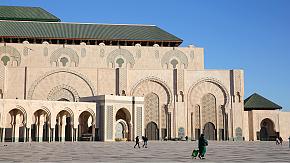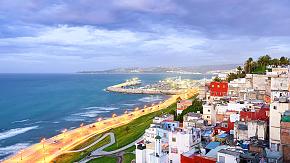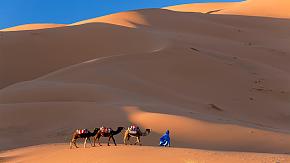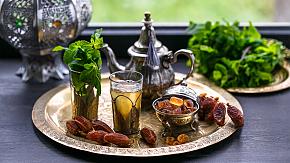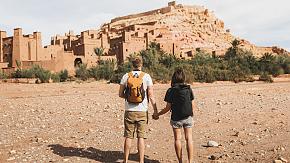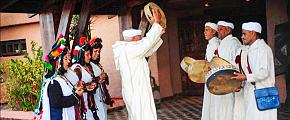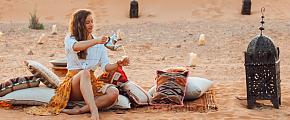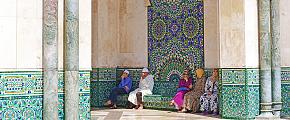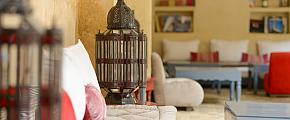Morocco's Photography Places to Capture Charming Moments
How do you define Morocco with one photo from your Morocco trip? Camels in the golden desert? A colorful spice stall in the Marrakech bazaar? Or a majestic mosque on the beach in Casablanca? This article will reveal the 10 best photography places in Morocco, sharing where to capture amazing pictures and exclusive tips, such as lighting, composition, and the best time to shoot. With this information, your lens can speak and your photos can tell stories.
- The Royal Palace of Rabat
- The Hassan II Mosque in Casablanca
- The Kasbah Ait Ben Haddou in Ouarzazate
- The Majorelle Garden in Marrakech
- The Royal Palace & Medina in Fez
- The Coastal Town of Essaouira
- The Blue City of Chefchaouen
- Tizi n' Tichka of High Atlas Mountains
- The Sahara Desert
- Legzira Beach Arch
- Tips for Photography Travelers
The Royal Palace of Rabat
The Rabat Royal Palace is an outstanding example of Morocco's architecture and design, characterized by intricate tiles, ornate gates, and Islamic geometric shapes and patterns. It is usually not open to the public. Nevertheless, you can choose symmetrical composition or close-up details to capture the exquisitely carved gate and its surrounding areas.
The ideal perspective for capturing the beauty of the Kasbah is from the top of the Kasbah walls. From this vantage point, you can capture the entirety of the Kasbah, as well as the surrounding area, including the ocean, Andalusian gardens, and the charming white and blue buildings of the Kasbah. Additionally, the viewpoint from the nearby Hassan Tower provides a panoramic view of the Kasbah and the city of Rabat. To capture the perfect lighting and atmosphere, early morning or late afternoon is the best time to take photos.
The Hassan II Mosque in Casablanca
The Hassan II Mosque in Casablanca sits on a promontory in the Atlantic Ocean and is one of the mosques in Morocco that allows non-Muslims to enter.
When the morning sun shines on its exquisite mosaic decorations, the subtle changes in light and shadow add a three-dimensional sense to the picture, allowing you to capture rich details. When the sun sets, the sky is rendered golden orange, forming a beautiful symmetrical picture.
It is recommended to use a wide-angle lens and take pictures from the seaside promenade or the nearby lighthouse to enjoy a panoramic view of the mosque and the ocean. What's more, you can try low-angle shooting to capture the gorgeous prayer hall and the amazing glass floor that reveals the ocean below.
The Kasbah Ait Ben Haddou in Ouarzazate
A location for numerous film shoots, Ait Ben Haddou stands at the foot of the High Atlas Mountains in Ouarzazate, on the edge of the Sahara. It is characterized by the use of flat roofs, thick walls, and small openings, as well as decorative features such as intricate tilework, carved plaster, and colorful zellige mosaic patterns.
If you want to take the most impactful picture, you can shoot from the high ground outside the city and include the magnificent outline of the entire fortress in the shot. The best time to take photos is early in the morning or later in the afternoon when the light is softer and more diffused, creating a warm and golden glow that enhances the colors and textures of the buildings and landscape. As for angles for photography, the view from the nearby hillside provides a great panoramic view of the Kasbah and its surroundings. Additionally, taking photos from the inside can provide interesting and unique perspectives of the site. You can capture the intricate details and textures of the buildings and even the daily life and activities of the locals with close-up shots.
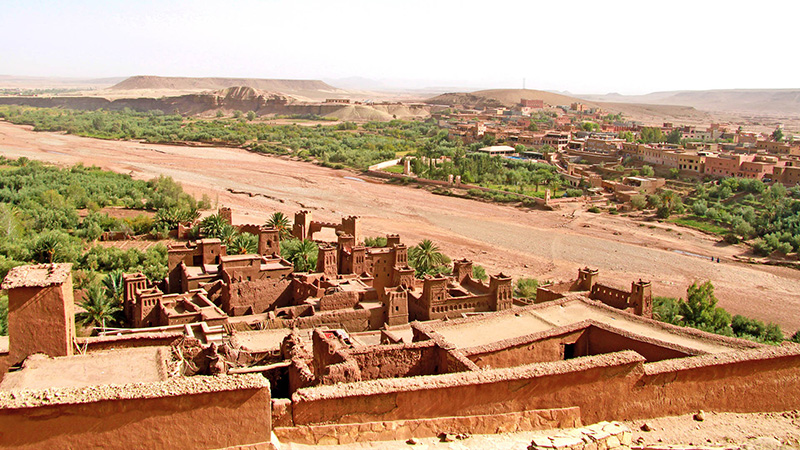 The Kasbah Ait Ben Haddou
The Kasbah Ait Ben Haddou
The Majorelle Garden in Marrakech
Designed by French painter Jacques Majorelle, the Majorelle Garden in Marrakech is a paradise for color photography enthusiasts. The iconic "Majorelle Blue" wall contrasts sharply with the yellow ceramics and emerald green cacti in the sun, giving the picture a strong visual impact.
The garden is open to visitors all year round, and in spring (March to May) and autumn (September to November), the garden is in full bloom, making it an excellent time to visit. In the early morning or evening, soft light can reduce reflections and make the colors more saturated. The garden's reflection pool and palm tree silhouettes are also not-to-be-missed elements. You can use a wide-angle lens to capture the expanse of the garden and its building, while a macro lens can capture the intricate details of the plants and flowers.
The Royal Palace & Medina in Fez
As a UNESCO World Heritage site, the Medina of Fez is also known as Fes el Bali and is famous for its narrow alleyways, bustling souks (markets), ancient mosques, and stunning architectural wonders. You can capture intricate mosaics, carved plasterwork, and ornate tilework.
Apart from taking photos of the Royal Palace of Fez, strolling along Talaa Kebira Street, a bustling street in the heart of Medina known for its colorful shops and markets, allows for capturing the details of the goods being sold, as well as the lively atmosphere of the market. Additionally, Bou Inania Madrasa, a beautiful Islamic school with stunning architecture and intricate tilework, is a great spot to capture up-close shots during the day.
The Coastal Town of Essaouira
Essaouira is a charming coastal town in Morocco, known for its blue and white buildings and fishing harbor. During the shoulder seasons of spring (March to May) and autumn (September to November), there are fewer crowds and mild weather. However, visiting during the summer months (June to August) is also a great option to capture the town's vibrant energy and bustling markets.
One of the best shooting spots is the blue fishing boats in the harbor, with brightly colored boats arranged in geometric compositions in the morning light, creating a visually impactful scene. In addition, seagulls dance in groups, forming a highly dynamic image under the sunset. Ascending to the top of the citadel walls to take photos from above can be a great option. This angle enables you to capture the citadel's layout and its surroundings, including the ocean and nearby buildings.
The Blue City of Chefchaouen
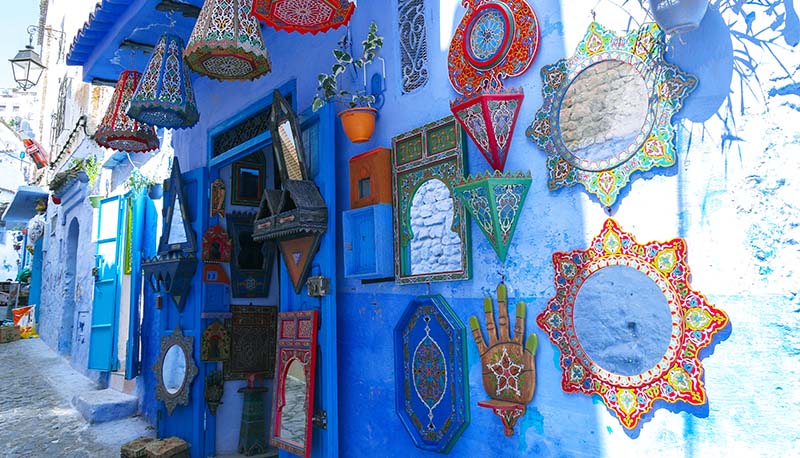 The Blue City of Chefchaouen
The Blue City of Chefchaouen
Chefchaouen, known as the Blue City, is the "Blue Pearl of Morocco". Its blue walls and buildings make it a photographer's dream. It is a great destination for photography year-round, but the ideal time to visit and take photos is during the mild weather of spring (March to May) or autumn (September to November).
You can take photos in the early morning and late evening, when the slanting sunlight casts warm golden shadows on the blue streets, adding a dreamy sense of layering to the photos. The Spanish Mosque, located on a hilltop overlooking the city, offers a panoramic view of the city and its surroundings. The narrow alleys and colorful souks in the old town provide a picturesque backdrop. Close-up shots of the intricate details and patterns on doors and windows can also make for great photos. Additionally, taking photos of locals in their colorful traditional clothing can result in stunning portraits. However, it's important to always ask for permission from the locals before taking their photo.
Tizi n' Tichka of High Atlas Mountains
Tizi n' Tichka is a mountain pass in Morocco's High Atlas Mountains, with dramatic mountain peaks, deep valleys and winding roads. While the pass is generally open year-round, it may be closed in winter (typically between January and April) due to snowfall. Checking the forecast to avoid unsuitable weather is advisable.
It is recommended to visit in spring or autumn (March to May and September to November respectively), you will see a landscape of valleys, villages, and snowy peaks. A fantastic spot to take photos is the roadside lookout, offering a panoramic view of the mountains and the valley below. Another wonderful location for photography is the Toubkal National Park or Ouanoukrim, for a bird's eye view of the entire region. Additionally, driving through the mountains can provide intriguing viewpoints and compositions for photos. Feel free to contact Odynovo to explore the area, you'll enjoy our comfortable services and gain an unforgettable experience.
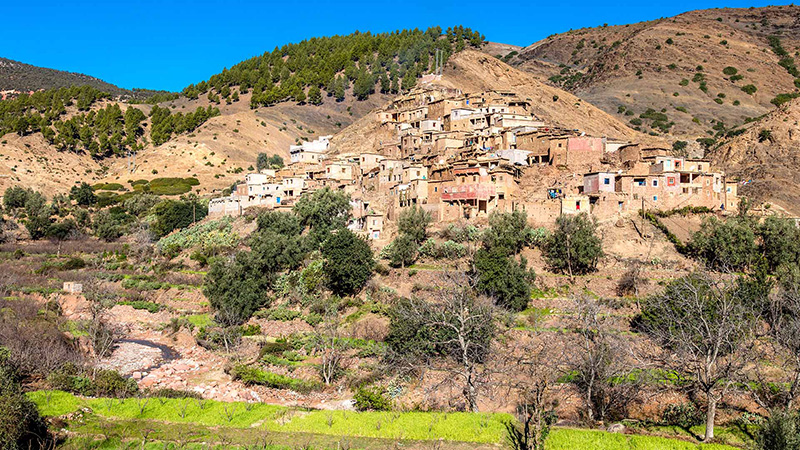 Berber Villages in Atlas Mountains
Berber Villages in Atlas Mountains
The Sahara Desert
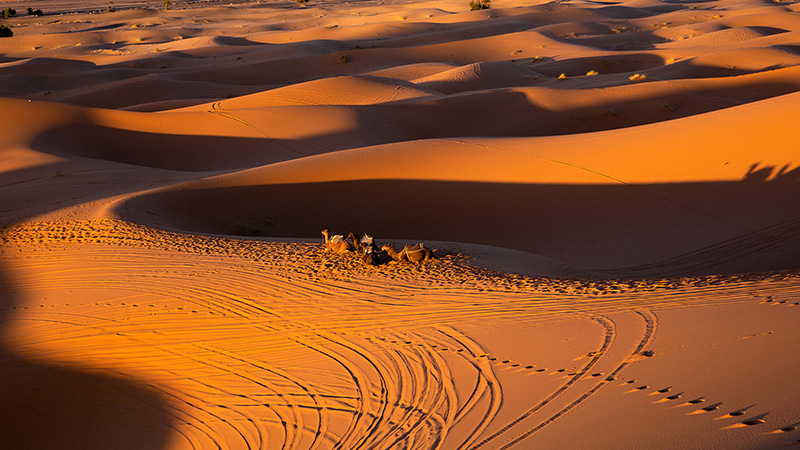 The Sahara Desert
The Sahara Desert
The Sahara Desert in Morocco, covers a large portion of the country's southern region, and you could plan your visit to coincide with the "golden hours" of early morning or late afternoon during March-April, or October-November, when the shifting colors of the sand during sunrise and sunset create a magical experience, while the night sky is adorned with millions of twinkling stars.
The Erg Chebbi dunes near Merzouga and the Erg Chigaga dunes near M'Hamid El Ghizlane are renowned locations for photographers. Shooting during sunrise or sunset in the Erg Chebbi dunes can create a stunning silhouette effect against the colorful sky. The sand texture in the Erg Chigaga dunes can be captured through close-up shots. Additionally, capturing portraits of people or camels with the nomadic Berber camps in the background can make for great cultural photography.
Legzira Beach Arch
Legzira Beach Arch is a stunning natural arch formation located on Morocco's southern Atlantic Coast. Comprised of two red stone cliffs that create a bridge-like formation over the Atlantic Ocean, this hidden gem is nestled between the small towns of Mirleft and Sidi Ifni.
In the morning or at sunset, warm light can illuminate the arch in unique ways, creating a dramatic interplay of light and shadow. You can shoot with a wide-angle lens to add a magical touch to your images and give them a dreamlike quality. Additionally, the unique rock formations surrounding the arch make great photography subjects. Take wide-angle and low-angle shots of the towering cliffs, small rock pools, and crashing waves against the shore, to add depth and interest to your images.
Tips for Photography Travelers
1. Respect local customs and dress modestly. Before taking photos of people, particularly women, always ask for permission.
2. Be aware of the weather and lighting conditions. Due to the high temperature and intense sunlight, it's advisable to bring sunscreen, a hat, and sunglasses.
3. Picking up the right gear. From street photography to landscapes and architecture, Morocco has plenty of photography opportunities. Depending on your interests, make sure to pack the right gear.
4. Using a polarizing filter for better results. To reduce glare and reflections and enhance the colors and contrast in your photos, consider using a polarizing filter.
5. Be patient and observant. Take your time to explore your surroundings and wait for the perfect moment to take your shot. Additionally, joining a photography workshop or tour led by a local expert can offer valuable guidance and insights.
Capture Morocco's Charm With Odynovo
Morocco is heaven for photographers, offering an exceptional mix of awe-inspiring natural landscapes, cultural heritage, and vibrant hues. With the above tips in mind, your photos will truly reflect the unique beauty of Morocco. If you're planning a trip to Morocco, please write to [email protected]. At Odynovo, we'll customize your itinerary to ensure you experience the best of Morocco according to your preferences.
What Our Clients Say
Explore the latest verified reviews of Odynovo's travel services on Tripadvisor, Google, Trustpilot, Product Review and more trusted platforms.

